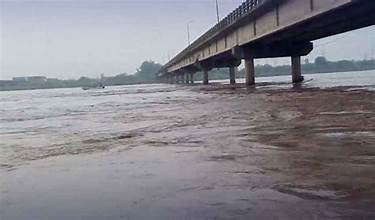The monsoon season, a vital source of water for agriculture and daily life, has once again brought with it both blessings and challenges. In Punjab, the onset of the monsoon has led to rivers swelling beyond their normal levels, creating a situation that is raising alarms across the province. Rising floodwaters have already begun to grip the major rivers, threatening not only the fertile farmlands but also the lives and livelihoods of thousands of people living along the banks. This recurring seasonal challenge underscores the delicate balance between nature’s abundance and its destructive force.
The Seasonal Cycle and Its Impact
Monsoon rains are an essential lifeline for Punjab, replenishing groundwater reserves and supporting crops like rice, wheat, sugarcane, and cotton. Yet, the excessive downpours often overwhelm the natural drainage systems and river channels. This year, the rains arrived with unusual intensity, pushing water levels in rivers such as the Sutlej, Chenab, Ravi, and Jhelum to dangerous highs. Meteorological departments had earlier warned of above-average rainfall in the region, and those predictions are now manifesting in the form of high flood levels.
Communities living near the riverbanks are the first to feel the brunt of this surge. Houses built on low-lying terrain are especially vulnerable, with water encroaching into courtyards and farmland. Crops standing ready for harvest face the risk of destruction, raising fears of food insecurity in the coming months.
Human Cost of Flooding
Behind the statistics and satellite images lies a human story. Families in flood-affected villages are being forced to abandon their homes, moving to temporary shelters with whatever belongings they can carry. In many cases, cattle and livestock—considered a primary source of livelihood—are left behind, exposing them to drowning or disease. For the rural poor, already living on the margins, the floods mean an additional layer of hardship that could take months, if not years, to recover from.
The displacement of people also increases pressure on relief camps, where overcrowding, poor sanitation, and limited food supplies can lead to outbreaks of waterborne diseases. Health officials have already raised concerns about the spread of diarrhea, malaria, and dengue in flood-hit zones. Thus, the rising water levels are not just an environmental challenge but a full-blown humanitarian crisis in the making.

Historical Parallels
Punjab is no stranger to floods. Historically, the province has seen devastating inundations during monsoon seasons, with some years witnessing catastrophic damage to agriculture and infrastructure. The recurring pattern highlights structural challenges: weak embankments, encroachment on riverbeds, and inadequate drainage networks. While the government has invested in flood control measures over the decades, the growing unpredictability of weather patterns due to climate change complicates the situation further.
This year’s scenario draws parallels with past flood events, but the intensity and unpredictability appear sharper. The lessons of history remind us that proactive planning and disaster preparedness are key to mitigating the impact of such natural events.
Climate Change and Intensified Rains
One cannot discuss monsoon floods without addressing the larger picture of climate change. Scientists have consistently warned that global warming is amplifying weather extremes. Rising temperatures lead to heavier rainfall in shorter periods, overwhelming natural and man-made systems alike. For Punjab, a region already heavily dependent on agriculture, climate-induced flooding presents an existential challenge.
Farmers, in particular, face a dual burden. On one hand, they need monsoon rains for crop irrigation; on the other, excessive rains destroy standing crops and erode soil quality. This cycle contributes to reduced yields and economic losses, further exacerbating rural poverty.
Government Response and Relief Efforts
Authorities in Punjab have been mobilizing resources to contain the damage. Rescue teams have been deployed in flood-prone areas, and evacuation measures are underway. Boats, life jackets, and emergency rations are being sent to villages along the swollen rivers. The irrigation and flood control departments are on high alert, monitoring water levels round-the-clock.
However, challenges remain. Delayed evacuation orders, limited resources, and weak infrastructure make it difficult to respond effectively. Villagers often hesitate to leave their homes out of fear of losing property or livestock, complicating evacuation drives. In addition, bureaucratic hurdles and logistical gaps often delay relief distribution.

Community Resilience
Despite these difficulties, the resilience of local communities shines through. Neighbors support each other by sharing food, shelter, and labor. Volunteers and local NGOs are stepping in to provide immediate assistance, often bridging gaps left by official relief measures. Community-driven responses, although small in scale, play a crucial role in reducing suffering during such crises.
The spirit of resilience is rooted in Punjab’s history, where floods, droughts, and natural challenges have always been part of the landscape. Yet, resilience alone cannot be the only line of defense. Long-term solutions require systemic reforms in flood management, land use, and environmental protection.
Long-Term Solutions
Experts emphasize that Punjab needs a more sustainable flood management strategy. Strengthening embankments, expanding drainage networks, and restoring natural floodplains could reduce the impact of seasonal floods. At the same time, improving forecasting systems and early warning mechanisms can give communities more time to prepare and evacuate.
Equally important is addressing the root cause: climate change. Reducing carbon emissions, investing in renewable energy, and adopting climate-smart agricultural practices can mitigate future risks. International cooperation and financial support are also vital, given that Pakistan contributes minimally to global emissions yet faces some of the harshest consequences.
The Way Forward
The rising floodwaters gripping Punjab rivers during the monsoon onset are a stark reminder of nature’s unpredictability and power. While floods are part of the ecological cycle, the damage they cause to human lives, livelihoods, and infrastructure cannot be ignored. The immediate priority lies in ensuring safety, delivering relief, and preventing disease outbreaks. But the long-term challenge is far greater: building resilience in the face of climate change and ensuring that the people of Punjab are not caught off guard every monsoon season.
The floods of today carry lessons for tomorrow. If those lessons are acted upon with sincerity, Punjab can transform its vulnerability into strength. But if ignored, the province risks repeating the cycle of destruction year after year.



